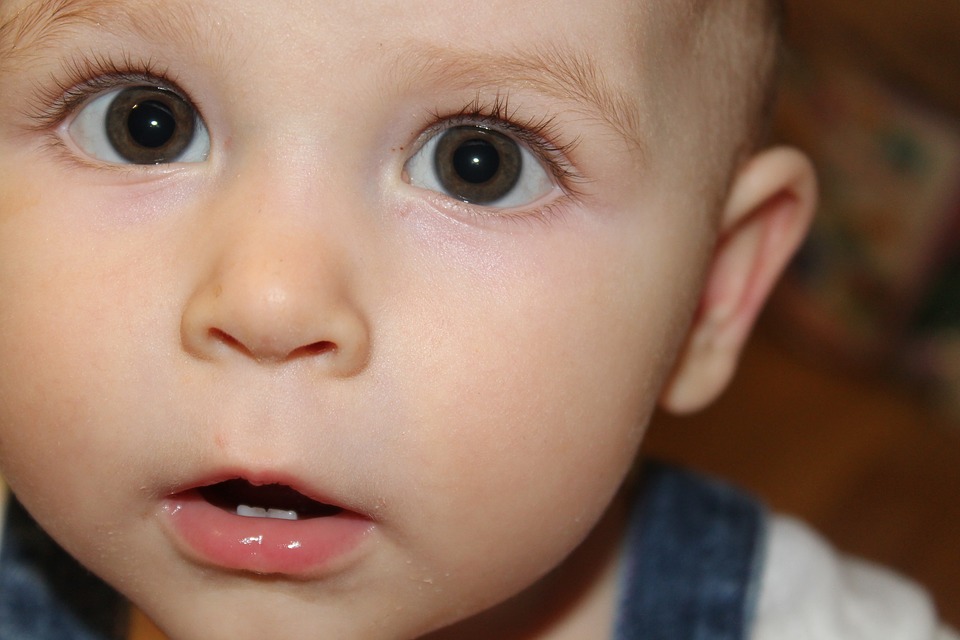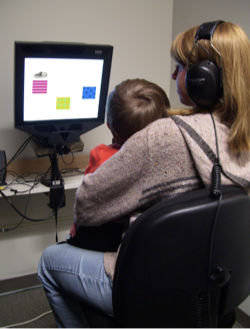Researchers, like us, are interested in studying how your baby grows, develops, and learns new things. We ask questions about different aspects of development, such as language, memory, social development, and more! But unlike research in adults, you can’t give a baby a survey or have them complete tasks on a computer — scientists have to be a little bit more clever to probe at what’s going on inside your baby’s mind. There are many different safe and baby friendly ways that researchers can study infants’ behaviors and the brain regions involved even before they can talk. This module will give a brief description of these methods.

Looking time is a common behavioral technique to explore what your baby perceives and finds compelling in the world around them. From birth, your baby is able to see the world around them and use their eyes to explore new faces, objects, and scenes. Thus, looking time allows researchers to ask questions about infant perception, cognition, language, social development, and more before your baby can even speak. There are several ways researchers can measure looking time, such as total looking time, direction of first look, etc. One method researchers use is habituation/dishabituation. Babies prefer to pay attention to new things, so when they become accustomed to items in their environment they start to pay less attention to them. This can be tested by having researchers repeatedly present an object to a baby. Typically, an infant’s looking time will decrease as the item becomes familiar to them. This is called habituation. When the infant is presented with a new item, their interest is peaked and they will look for longer. This is called dishabituation.
Eye tracking allows researchers to view what babies are looking at in real time and how their gaze shifts. There are two types of eye tracking setups. Head-mounted eye trackers are worn by a baby as a cap or band, and are lightweight to not make it difficult for the baby to move their head. Two cameras are used to track your baby’s eye movements as they watch the display in front of them. The second type are remote eye trackers. This tracker is placed in front of a baby to track their gaze at images or scenes displayed on a computer screen right above the tracker. This technology allows researchers to ask different questions about babies’ development, such as what kind of expectations they form about where objects will appear, by looking at their moment-to-moment changes in eye movement.

Another method used by researchers to study infant development is electroencephalogram, (EEG). Small discs are placed as a little hat on infants’ heads. This records the electrical signals from a baby’s brain. Researchers will look at which brain regions are active when an infant is looking at objects, scenes, etc. on a computer screen. This is a non-invasive, safe, and baby friendly way for researchers to study the relationship between babies’ brains and their behaviors.
Functional Near-Infared Spectroscopy (fNIRS) is another way researchers measure the brain activity of babies. The fNIRS sensors are placed as a little hat on an infant’s head. This system is lightweight and silent, allowing infants to freely move their head around and participate in tasks that contain both visual and auditory stimuli. fNIRS uses low levels of light to measure changes in blood flow in the brain. More specifically, as a baby is performing a task, such as looking at items on a screen, neurons in an area of the brain will become active. Oxygenated blood rushes in to re-energize them, and fNIRS measures this change in blood oxygenation levels through the amount of light shining through. fNIRS allows researchers to ask interesting questions about infant cognition and development while they are awake and behaving.

Lastly, researchers use a technique called functional magnetic resonance imaging (fMRI) to explore the relationship between babies’ brains and their behaviors. New research methods have been implemented to take pictures of an infant’s brain while they are awake and behaving. fMRI uses a powerful magnet to measure the location of activity in the brain. When a baby’s brain becomes active as they are performing a task, oxygenated blood rushes to that brain area. Researchers are able to detect this change using fMRI because oxygenated and deoxygenated blood have different magnetic properties. The images that fMRI takes are very precise; so precise, in fact, that if you chose to participate in an fMRI study with your baby, we could give you a 3D print-out of your child’s brain!
fMRI is a completely safe and non-invasive technology that has the power to answer many questions about how our brains work. In the past 20 years since fMRI has been used as a tool to study the human brain, over 40,000 papers in adults have been published. Only recently has fMRI begun to illuminate questions about child development, so, if we do say so ourselves — it’s an exciting time to be a researcher in developmental neuroscience!
Supplementary Material
For additional information and resources, take a look at the following.
1. To learn more about how eye tracking is implemented for research in infants, check out this article titled “Looking This Way and That, and Learning to Adapt to the World” from the New York Times.
2. Want a cool example of these research methods in action? Check out this article by the Smithsonian Magazine, detailing a study done by researchers at the University of Florida. It’s a great example of how eyetracking and EEG can be combined to help us better understand what’s really going on when we read to our babies each night during story time! In turn this has helped us optimize what books are best for children at different ages.
3. Curious about how we use fMRI to learn more about the developing mind? Check out this article by Quanta Magazine for a story both about how fMRI research in babies works, and all the incredible things that we can learn from it!
References
Bell, M. A., & Cuevas, K. (2012). Using EEG to study cognitive development: Issues and practices. Journal of Cognition and Development, 13(3), 281-294.
Corbetta, D., Guan, Y., & Williams, J. L. (2012). Infant Eye‐Tracking in the Context of Goal‐Directed Actions. Infancy, 17(1), 102-125.
McDonald, N. M., & Perdue, K. L. (2018). The infant brain in the social world: moving toward interactive social neuroscience with functional near-infrared spectroscopy. Neuroscience & Biobehavioral Reviews.
Oakes, L. M. (2010). Using habituation of looking time to assess mental processes in infancy. Journal of Cognition and Development, 11(3), 255-268.